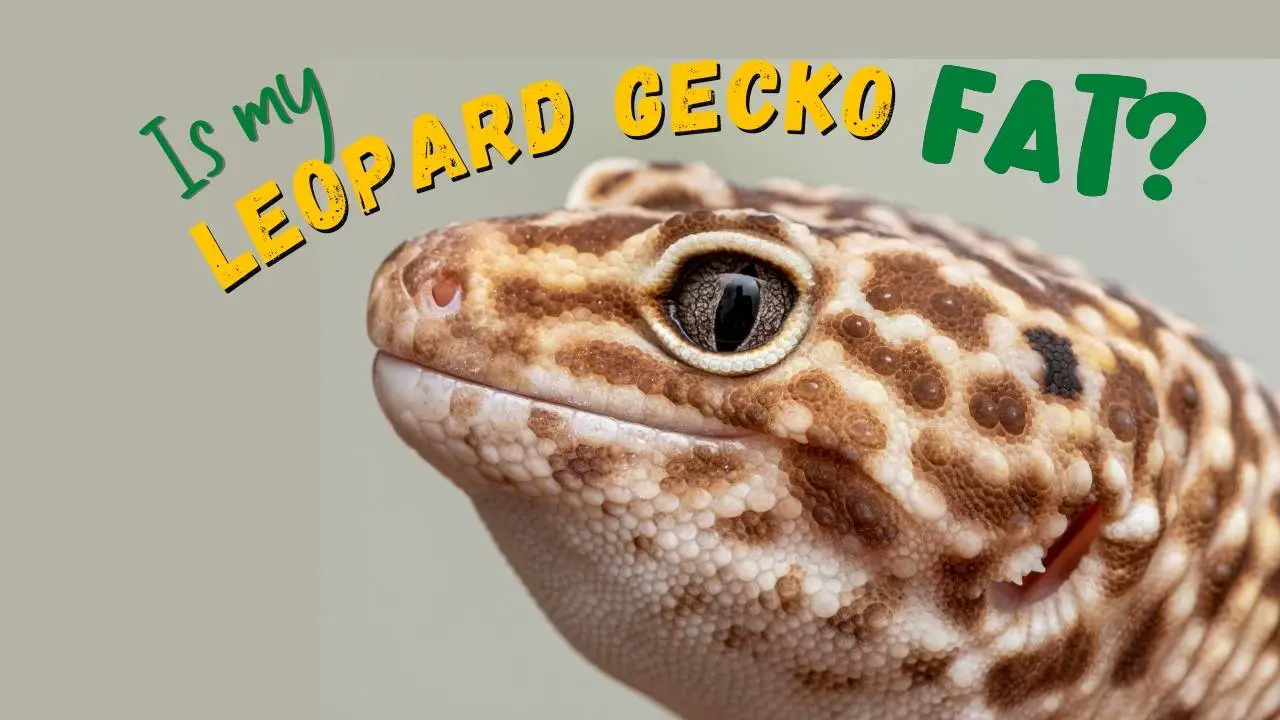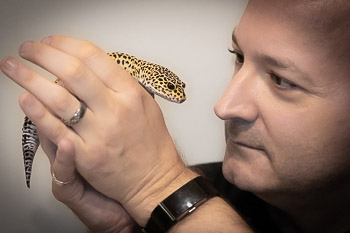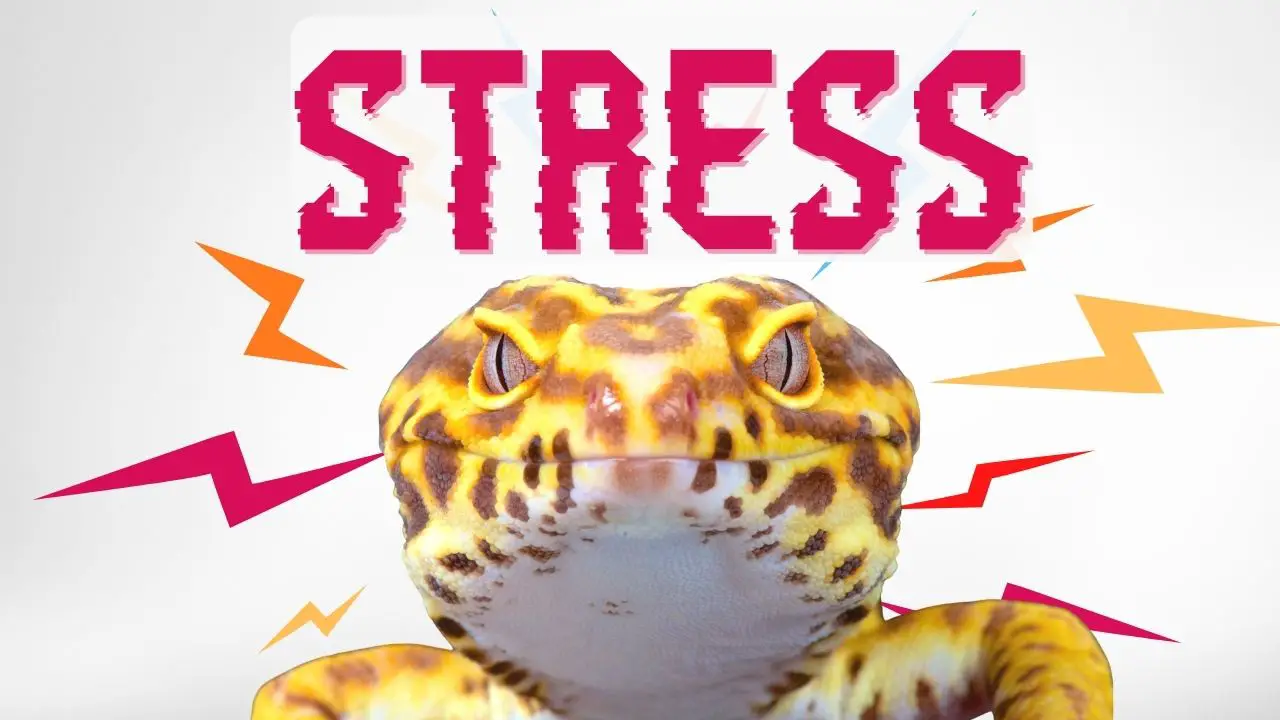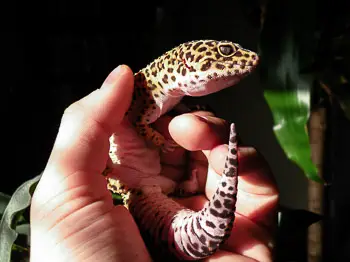We love our pets, and want to make sure they are comfortable and have enough of everything. Sometimes too much of a good thing is, well, just too much! If we give your lizard too much food, you may find yourself wonder, “Is my leopard gecko fat?”
An overweight leopard gecko can be at risk of developing serious health problems. We’ll look at the signs of an overweight leopard gecko, how to tell if your pet is healthy, and what steps you can take to ensure they stay fit and active. So let’s find out if your leopard gecko is overweight!
Healthy Weight for a Leopard Gecko
Before judging if your pet is overweight, it helps to understand what a normal weight should be. This will depend on the age and sex of your gecko, especially in the first year and a half of their life. A juvenile leopard gecko grows so rapidly, it’s hard to tell if they’re overweight or just edging ever closer to adulthood.
Generally, the average weight of a full grown leopard gecko should be between 50–100 grams. Females tend to be a bit smaller and lighter than males. Once your gecko is a year to a year and a half old, you’ll want to get a baseline weight and use the chart below to see how it stacks up:
| Months of Age | Male Weight (grams) | Female Weight (grams) |
|---|---|---|
| 1 | 10–20 | 10–20 |
| 6 | 30-45 | 30-40 |
| 12 | 55-60 | 40-50 |
| 18+ | 60-80 | 50-70 |
Besides just the raw numbers, there are other indicators that your leopard gecko may be overweight.
Related Post: How big do leopard geckos get?
Signs of an Overweight Leopard Gecko
It’s important to keep an eye on your leopard gecko’s weight as it can be an indication of their overall health. Common signs of an overweight leopard gecko include fat rolls around the stomach area, a distended abdomen, a tail wider than its head, bubbles or bulges in its armpits, fat on the legs, and a general lack of interest in physical activity.
In order to determine if your gecko is overweight, observe how it behaves and moves. Is it sluggish? Does it move slowly? Is there extra fat on their legs? Observe its behavior and movements.
If you think your leopard gecko may be fat, here are some signs to look out for:
- Armpit Bubbles
- Excess Body Fat or fat rolls
- Tail is wider than the head
- Swollen looking legs
- Lethargy
The tail is often a good indicator of leopard gecko health. Fat reserves are stored in the tail, so it should be plump, but not wider than the gecko’s head. On the other end of the spectrum, if the tail is too thin it may be a sign of malnutrition, loss of appetite, or stick tail. A checkup with a vet may be in order.
Related Post: How to tell if your leopard gecko is sick and learn about leopard gecko health issues.
Causes of an Overweight Leopard Gecko
An overweight gecko can be caused by a variety of factors. Identifying the underlying cause can help you get your gecko back on track to a healthy weight.
Overfeeding is by far the most common cause of an obese leopard gecko, as some owners may not be aware of how much food their reptile pet needs.
Other causes include fatty liver disease, parasitic infections, and even age.
If you think your leopard gecko is overweight, then it’s important to take them for a checkup with a vet that specializes in exotic animals. Your vet will be able to help diagnose any underlying issues that could be causing your pet to gain weight and offer advice on how best to help them get back to a healthy weight.
Genetics
Genetics not only determine how your gecko looks, but is a contributing factor in overall health and wellness. It’s important to remember that if your pet may be genetically inclined to gain weight, you can help them stay healthy by providing them with the right diet and exercise.
Lack of Exercise/Activity Level
It’s important for leopard geckos to stay active in order to maintain a healthy weight. Unfortunately, many owners don’t provide their pets with enough opportunities to exercise and explore. Without adequate activity, your pet can quickly become overweight, leading to a variety of health issues and a shorter lifespan.
To keep your gecko happy and healthy, ensure they have plenty of room to move around in their enclosure. You can also get creative and provide interactive objects such as climbing branches, rocks, or tunnels for your pet to explore. Not only will these items help them stay physically active, but they’ll also add an element of playtime fun!
Diet/Nutrition
When it comes to nutrition, leopard geckos usually aren’t too fussy eaters. They mainly feed on insects such as crickets and mealworms.
A proper diet is essential for a leopard gecko’s health – without it, they can quickly become overweight or suffer from fatty liver disease. To ensure your pet gets all the nutrients they need, offer them different types of food in small amounts.
Leopard Geckos go crazy for wax worms, and it’s okay to offer these as an occasional treat. Wax worms are high in fat content – think of them as lizard cupcakes.
Regardless of what feeder insects you’re using, take care to avoid overfeeding – if your gecko looks like they’re putting on weight or developing “fat rolls,” reduce its portion size and frequency until they reach a healthy weight again.
Finally, don’t forget that a female leopard gecko will require more nutrition than males due to their higher metabolic rate, especially if they are breeding. Egg production takes a toll on the body.
Prevention and Treatment of an Overweight Leopard Gecko
Keeping your pet leopard gecko at a healthy weight is important. If you’re noticing fat rolls, armpit bubbles, or other signs of being overweight, your pet may be in need of some dietary adjustments.
If your gecko is already overweight, reducing portion sizes and frequency can promote weight loss until they reach their target weight. This should be done gradually so as not to shock their system – slow and steady wins the race!
Keep an eye out for any changes in behavior or appetite that may indicate underlying health issues.
Leopard geckos need proper diet and nutrition to stay healthy and at an ideal weight. With some thoughtfully-planned meals and regular monitoring, you can ensure your pet’s wellbeing is taken care of!
Appropriate Diet and Nutrition
Having the right diet and nutrition plan is essential for a healthy leopard gecko.
Leopard geckos are insectivores, meaning their diet should consist mainly of insects. If you’re sticking to the staple of crickets and mealworms and need a little variety to keep your leopard gecko healthy, try working some dubia roaches into its diet.
Check out our feeding guide to make sure you’re providing the correct diet for your gecko.
Exercise/Activity Level
Just like humans, leopard geckos need exercise to stay healthy. Regular physical activity can help your pet maintain a healthy weight and muscle mass, while reducing stress levels at the same time. You can provide your gecko with plenty of stimulation by providing them with climbing structures, hiding spots, and toys.
Make sure you allow enough space for them to roam around. A juvenile may be fine in a 10-gallon tank, though an adult leopard gecko will do better in a 20 gallon tank. You may also consider taking them out and giving them more room to run – a pet pen like this one will let you do that safely.
Veterinary Care
As a leopard gecko owner, it’s important to make sure your pet is receiving the best care possible. While regular exercise and activity are essential in keeping your gecko healthy and happy, it’s also important to take them to the vet for routine check-ups. During these visits, your vet can assess their overall health and look for signs of obesity or other potential issues that may be present.
If you notice any changes in behavior – such as lethargy or loss of appetite – this could be an indication that something is wrong and it is always wise to take them to the vet. Your vet will be able to provide a tailored treatment plan depending on the issue at hand, whether it’s parasites, a bacterial infection, or simply just age-related concerns.
Finally, being aware of the ideal weight range for juvenile and adult leopard geckos can help you keep an eye on their progress over time; if needed your vet can provide helpful tips on how to maintain a healthy weight for your pet!
Wrap Up – How to Tell if a Gecko is Overweight
It’s important to monitor your leopard gecko’s weight, as being overweight or underweight can cause more serious health problems.
It’s important to remember that a healthy leopard gecko is not only happier, but also lives longer and has a more vibrant life. A good diet should consist of small insects like mealworms and crickets. Make sure they have plenty of room to move around in their enclosure and provide opportunities for them to explore.
With the right diet and exercise, you can ensure that your beloved pet stays fit and happy for many years to come.





